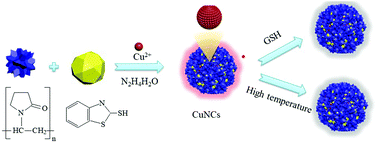Orange-red emitting copper nanoclusters for endogenous GSH, temperature sensing, and cellular imaging†
Abstract
Glutathione (GSH) plays an important role in the biochemical defense system of the human body. Designing an exceptional probe to detect trace amounts of GSH is of great significance for studying the oxidative stress reaction and related diseases. In this study, a selective and sensitive orange-red emitting copper nanocluster(CuNC)-based fluorescent probe for the detection of GSH was devised in the matrix of polyvinylpyrrolidone (PVP) using hydrazine hydrate (HYD) as the reducing agent and 2-mercaptobenzothiazole (MBT) as the stabilizer. A peaceable without external assistance method (room temperature reaction) was employed to synthesize fluorescent CuNCs with orange-red luminescence emission at 606 nm upon excitation at 377 nm. The fluorescence intensity of CuNCs was found to decrease or even quench by the addition of GSH, which indicated the stronger binding ability of –SH in GSH with the CuNCs losing the protection of PVP. Based on this principle, the present sensor system exhibits a good linear response towards GSH ranging from 0.10 to 40 μM, and the limit of detection was found to be 12.4 nM. Moreover, due to the excellent selectivity and high sensitivity of the GSH sensor, it might act as a potential probe for the detection of GSH in the lysosomal environment of tumor cells. Thus, this strategy has a promising application potential for the early identification and prevention of cancer with low toxicity and good stability.



 Please wait while we load your content...
Please wait while we load your content...